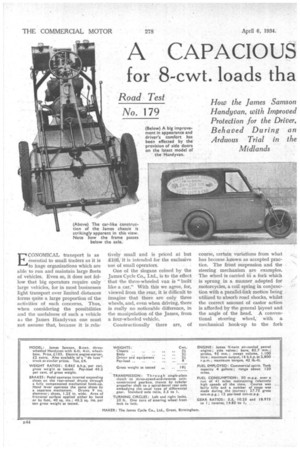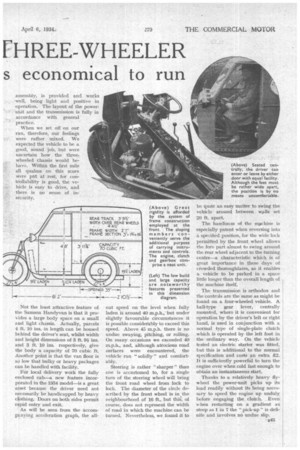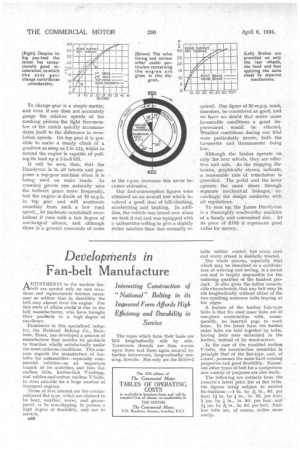A CAPACIOUS
Page 62

Page 63

Page 64

If you've noticed an error in this article please click here to report it so we can fix it.
iHREE-WHEELER
for 8-cwt. loads tha
s economical to run
How the James Samson Handyvan, with Improved Protection for the Driver, Behaved During an Arduous Trial in the Midlands
ECONOMICAL transport is as essential to small traders as it is to huge organizations which are able to run and maintain large fleets of vehicles. Even so, it does not follow that big operators require only large vehicles, for in most businesses light transport over limited distances forms quite a large proportion of the activities of such concerns. Thus, when considering the possibilities and the usefulness of such a vehicle as the James Handyvan one must not assume that, because it is .rela -lively small and is priced at but it is intended for the exclusive use of small operators.
One of the slogans coined by the James Cycle Co., Ltd., is to the effect that the three-wheeled van is "built like a car." With this we agree, for, viewed from the rear, it is difficult to imagine that there are only three wheels, and, even when driving, there is really no noticeable difference, in the manipulation of the James, from a four-wheeled vehicle.
Constructionally there are, of
course, certain variations from what has become known as accepted practice. The front suspension and the steering mechanism are examples. The wheel is carried in a fork which is sprung in a manner adopted for motorcycles, a coil spring in conjunction with a parallel-link motion being utilized to absorb road shocks, whilst the correct amount of castor action is afforded by the general layout and the angle of the head. A conventional steering wheel, with a mechanical hook-up to the fork
assembly, is provided and works :well, being light and positive in operation. The layout of the powerutiit and the transmission is fully in accordance with general practice.
When we set off on our run, therefore, our feelings were rather mixed. We expected the vehicle to be a good, sound job, . but were uncertain how the threewheeled chassis would behave. Within the first mile all qualms on this score were prit at rest, for controllability is good, the vehicle. is easy to drive, and there is no sense of in. security.
Not the least attractive feature of the Samson Hand3rvan is that it provides a large body space on a small and light chassis. Actually, parcels 4 ft. 10 ins, in length can be housed behind the driver's seat, whilst width and height dimensions of 3 ft. 9i. iris. and 3 ft. 10 ins. respectively, give the body a capacity of 70 cubic ft. Another point is that the van floor is S3 low that bulky or heavy packages can be handled with facility.
For local delivery work the fully enclosed cab—a new feature incorporated in the 1934 model—is a great asset because the driver need not necessarily. be handicapped by heavy clOthing. Doors on both sides permit rapid entry and exit.
As will be seen from the accompanying acceleration graph, the all
out speed on the level when fully
laden is around 40 m.p.h., but under slightly favourable circumstances it is possible considerably to exceed this speed. Above 45 nn.p.h, there is no undue swaying, pitching, or rolling. On many occasions we exceeded 40 m.p.h., and, although atrocious road surfaces were encountered, the vehicle ran " solidly " and comfortably.
Steering is rather " sharper " than one is accustomed to, for a single turn of the steering wheel will bring the front road wheel from lock to lock. The diameter of the circle described by the front wheel is in the neighbourhood of 16 ft., but tha, of course, does not represent the width of road in which the machine can be turned. Nevertheless, we found it to
be quite an easy matter to swing the vehicle around between walls set 20 ft. apart.
The handiness of the machine is especially patent when reversing into a specified position, for the wide lock permitted by the front wheel allows the fore part almost to swing around the rear wheel adjacent to the turning centre—a characteristic which is of great importance in these days of crowded thoroughfares, as it enables a vehicle to be parked in a space little longer than the overall length of the machine itself.
The transmission is orthodox and the controls are the same as might be found on a four-wheeled vehicle. A ball-type gear lever, centrally mounted, where it is convenient for operation by the driver's left or right hand, is used in conjunction with a normal type of single-plate clutch .which is operated by the left foot in the ordinary way. On the vehicle tested an electric starter was fitted, but this is additional to the normal specification and costs an extra £2. It is sufficiently powerful to turn the engine over when cold fast enough to obtain an instantaneous start.
Thanks to a relatively heavy flywheel the power-unit picks up its load readily without its being necessary to speed the engine up unduly before engaging the clutch. Even vhen restarting on a gradient as steep as 1 in 7 the " pick-up" is definite and involves no undue slip. To change gear is a simple matter, and even if one does not accurately gauge the relative speeds of the meshing pinions the light free-mern.ber of the clutch quickly accommodates itself to the difference in revolution speeds. On top gear it is possible to make a steady climb of a gradient as steep as 1 in 11-i, whilst in second the engine is capable of pulling its load up a 1-in-8 hill.
It will be seen, then, that the Handyvan is to all intents and purposes a top-gear machine when it is 'being used on main roads. In crowded streets one naturally uses the indirect gears more frequently, but the engine is docile at 1.0 m.p.h. in top geae. and will accelerate smoothly from such a low road speed. At moderate crankshaft revolutions it runs with a fair degree of mechanical silence, and although there is .a general crescendo of noise as the r.p.m. increases this never becomes obtrusive.
Our fuel-consumption figures were obtained on an overall test which involved a good deal of bill-climbing, accelerating and braking. In addition, the vehicle was brand new when we took it out and was equipped with a carburetter-setting to give a slightly richer mixture than that normally re quired. Our figure of 30.m.p.g. must, therefore, be considered as good, and we have no doubt that under more favourable conditions a great improvement would be effected. Weather conditions during our trial. were particularly severe, both the barometer and thermometer being low.
Although the brakes operate on cnly the rear wheels, they are effective and safe. As the stopping din' lances, graphically shown, indicate, a reasonable rate of retardation is provided. The pedal and the lever . operate the same shoes through separate mechanical linkages,accordingly the design conforms with all regulations.
To sum up, the James Handyvan ii a thoroughly roadworthy machine of a handy and convenient size. At its price of 103 it represents good value for money.




































































































